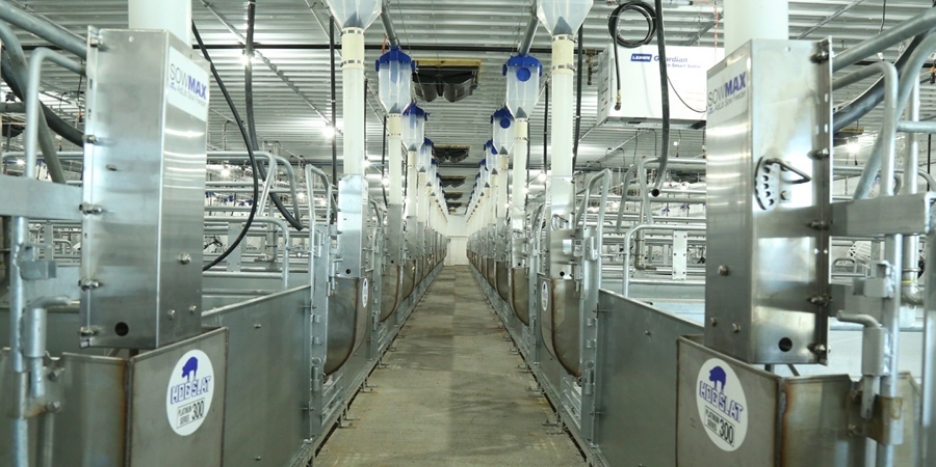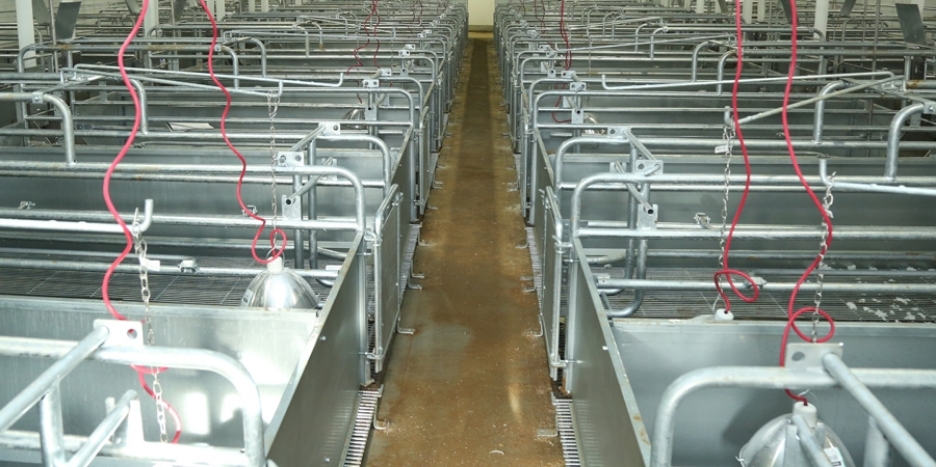Blog posts tagged with 'SowMAX'
Retro of existing farrowing rooms adds square footage to accommodate larger litters without reducing the total number of crates.
The size of individual sow farms continues to increase; just a few years ago 2,400 head units were considered large, but new sow farms under construction this year range between 5,000 to 14,000 head in size.
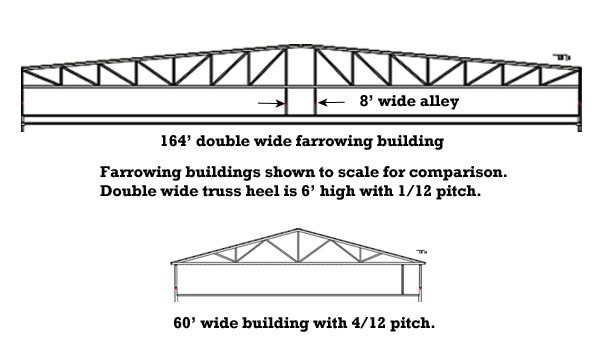
Building cross-section comparison
Designing the central production facility into two or three larger buildings has many advantages including smaller land requirements, less underground utilities to bring to the site, shorter roadways to build and maintain, fewer walkways between buildings and less linear footage of exterior building walls.
Because of increased pig capacities and the desire to minimize the number of buildings, it was necessary to increase the buildings widths up to 190 feet. Instead of the 4/12-pitch roof used on standard farm buildings, these jumbo-wide facilities utilize a two-piece rafter with a 1/12-pitch roof line resting on a center support wall in the middle. Almost 6 feet high at the heel with a center height of 13 feet, the rafters are designed more like a large floor joist. The outside appearance resembles a steel frame building more than conventional wood framed structures.
Breeding/ Gestation

Galvanized gestation stalls
Totally slatted flooring is a common feature of newly constructed B&G buildings. While past layouts consisted of a solid laying area with slat sections in the rear of the pen or stall only, new construction plans incorporate slats over the entire floor with stainless feeding troughs fastened in place. This arrangement allows long-term flexibility to reconfigure the pen layout in the future if needed.
Group housing with stanchions is the predominant type of housing under construction this year. Largely through trial and error, the industry seems to have settled into pen configurations containing eight to twelve sows. This pen size permits closer grouping by size and condition and promotes easier visual inspection.
Whether the production system chooses gestation stalls, stanchions, or ESF, most equipment is specified with hot-dipped galvanized equipment instead of painted finish. The extended equipment life provided by the galvanized finish makes this an economical business decision.
One advantage reported with stanchion systems is longer equipment life resulting from moving the water away from the front of the stanchions. Locating a cup or swinging water pipe with nipples in the center of the pen reduces the deterioration of feed pipes and stall fronts by minimizing water contact with these areas.
Farrowing
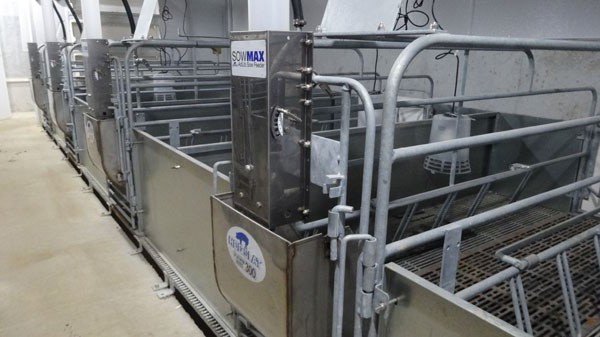
Large pen farrowing crates with SowMAX feeders
Jumbo style layouts permit designing a double farrowing building with an extra wide 8-foot center alleyway to aid in animal and people movement between rooms.
Almost every new construction project increases the length and width of the farrowing crates and creep area from the standard 5′ x 7′ footprint up to 6’ wide by 8′ long, with some systems choosing 8’6″ long crates. Longer framed sows and reduced piglet crushing rates from using wider pens have driven this trend. Again, the equipment will have a galvanized finish with a combination of cast iron, TriDek, or plastic slats for flooring choices.
Most production systems will incorporate some provision for ad-lib sow feeding. Besides reducing farm labor, ad-lib sow feeding is the most efficient method for feeding individual sows to reach full milk production potential. The type of systems can range from electronic transponder metering devices to sow activated hopper type feed dispensers.
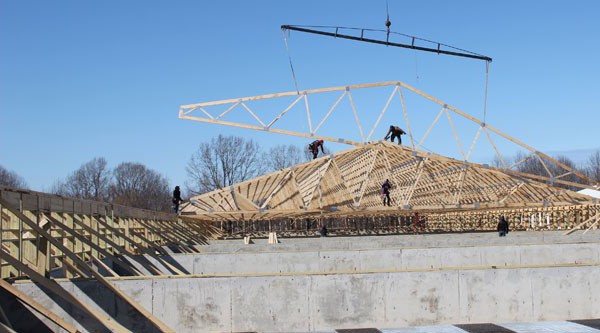
Swinging rafters on new farrowing house
Projects of this size require builders with an expanded skill set. A builder must be able to provide professional project management, understanding of regulatory issues, and increased insurance coverage. It is also critical for any construction firm undertaking projects of this size to have sufficient financial backing and the ability to manage large cash flows.
For more information about Hog Slat’s construction projects and swine production equipment offerings, contact your nearest sales representative by clicking here.
Here’s another selection from the 1960 edition of The Yearbook of Agriculture on the latest trends in farrowing.
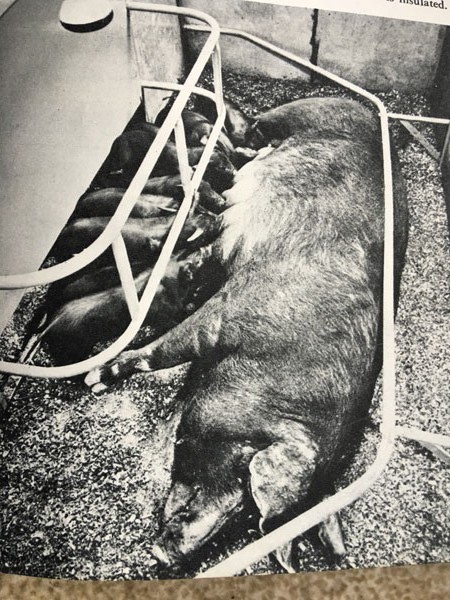
Welfare-friendly farrowing pens
Caption in yearbook:
In this minimum-stress pen, the shape of the guardrail encourages the sow to lie with the teats toward the pigs. The pigs stay where it’s warm – under the heat lamp and behind the guard.
How about this for Ad Lib feeding? An overhead auger delivers feed to the farrowing pens. No carts or scoops are needed.

Labor saving feeding from the past.
And finally, double-decker farrowing crates! I saw one of these set up in Red Oak, Iowa years ago.
From the yearbook:
Hogs in double-deck, all steel, cage-type farrowing stalls. The pigs are transferred after weaning. Manure is removed by mechanical drags.
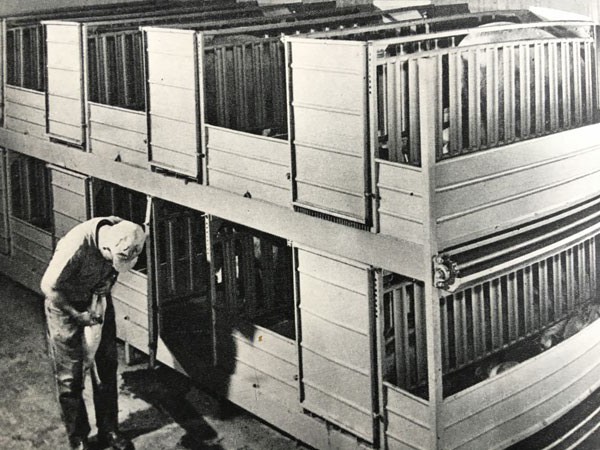
Double-decker farrowing crates.
Hog Slat manufactures a complete line of farrowing equipment for new construction or remodeling an existing facility. Our SowMAX ad lib dispenser feeds lactating sows 24/7 while reducing farm labor. See more at www.hogslat.com or call 800-949-4647.
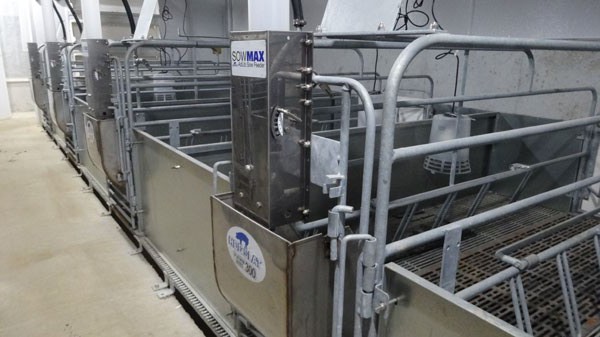
Galvanized Hog Slat farrowing crates with SowMAX Ad Lib dispensers, Cast/ TriDEK floors, and Poly Lamps
Hog Slat will be exhibiting at this year’s World Pork Expo with many new and further developed swine equipment products, highlighting Hog Slat’s GrowerSELECT product line.
At the show, Hog Slat will have a large variety of equipment on display in both the exhibition hall (Booth V165 VIB) and at the Hog Slat hospitality tent (Tent G234). Equipment that will be on display includes Hog Slat’s Grow-Flex Feed System, Grow-Disk Feed System, Slats, and an introduction to Hog Slat’s AirStorm fans. We invite you to stop by the Hog Slat booth to see what’s new at the show.
Enjoy FREE ADMISSION to the 2015 World Pork Expo, courtesy of Hog Slat. You may redeem your admission voucher by registering online at www.worldpork.org by May 28th and use voucher code HogSlat2015. Or, present a hard copy of our voucher (available through the Hog Biz, local Hog Slat retail stores, or your local sales contact) during on-site registration the day of the expo. Expo registration is located in the Animal Learning Center inside Gate 15.
Craving some good BBQ? Stop by the Hog Slat hospitality tent anytime during expo to enjoy Vinny’s BBQ, located in Dakota City, IA. Vinny’s will be serving lunch and dinner both Wednesday and Thursday of the expo.
The World Pork Expo is held June 3rd-5th in Des Moines, IA at the Iowa State Fairgrounds. Visit us at the show in booth V165 in the Varied Industries Building and Hospitality Tent G234. We hope to see you at the show!
Sow and Piglet Performance during Lactation for SowMAX Self Feeders and Hand Feeding
A synopsis of research study conducted at North Carolina State University.
The main objective of this study was to collect lactation and rebreeding data from sows fed with SowMAX self feeders opposed to sows that were hand fed. The secondary objective was to measure the amount of labor required to manage the sows using each type of feeding system, specifically during lactation. Two farrowing rooms were observed in this study. One-half of the farrowing crates in each room were retrofitted with SowMAX feeders. Farrowing occurs every other week at the Swine Educational Unit (n=24 sows per group). At the present time, data has been collected from 36 sows utilizing SowMAX feeders and34 sows that were hand fed.There were significant interactions between season (winter versus summer) and feeding strategy (SowMAX versus hand feeding) for both sow and piglet performance and sows’ daily feed intake patterns. Consequently, the data is presented seasonally. Sow and piglet performance during lactation is shown in Tables 1 and 2, while sow daily feed intake patterns are shown in Figure 1 and 2. Tables 3 and 4 contain sow rebreeding performance and baby piglet death losses, respectively. (see complete article online including tables) There were no significant interactions between seasons and feeding strategy for this data, therefore the means in these tables were averaged across seasons.
Total feed intake and daily feed intake appear to be superior for sows being fed with the SowMAX feeders. This was particularly true during the summer months.
The data in all the Tables are the mean values and the standard errors. The last column in each table is the p value, which is a measure of how different the means is statistically. In a general sense, the p value can be thought of in the following manner. If the experiment was repeated 1000 times, then one would expect the same result as indicated by the p value due to chance. For example, in Table 1 the p-value for total feed intake is 0.043. Sows fed with the SowMAX feeders consumed 17.2 lbs. more feed during lactation compared with those fed by hand. What this means is that there is less than 5% chance that this difference is simply due to chance and random events and a 95% chance that it is due to the SowMAX feeder. Conversely, the body weight of sows after farrowing has a p value of 0.671. What this means is that there is more than 50% chance that the differences observed are, in fact, due to chance or random events and not related to the way they were fed (SowMAX versus Hand Feeding). The p values in bold are those that are less than 0.05 that is considered to be highly significant in the scientific literature. In other words, there is a 95% probability that the current difference is due to the feeding system. The p values in bold italics are ones with p values between 0.05 and 0.20. These are considered important trends in scientific literature. Usually what happens with trends is that as more data is collected (more observations) then their p values move closer to 0.05.
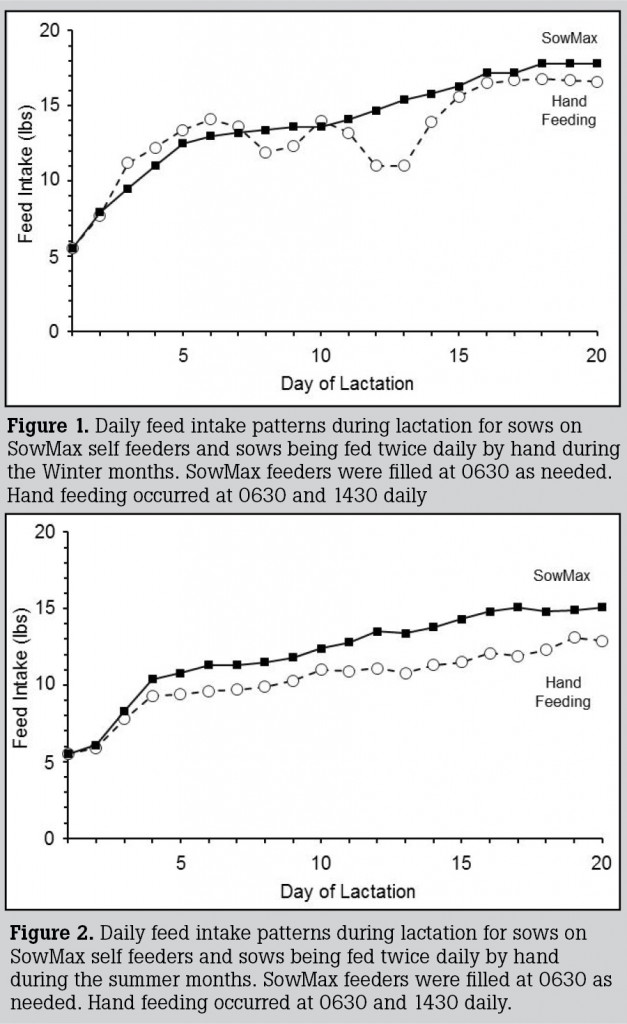
In general, both total feed intake and daily feed intake appear to be superior for sows being fed with the SowMAX feeders. This was predominantly true during the summer months. Daily sow feed intake was consistently greater during the summer with the SowMAX feeders after the first week of lactation compared to hand feeding. This was also true during the winter months due to a more consistent feed intake pattern over the entire lactation period, with less variation from day to day. During the summer, sows had a similar pattern of daily feed intake with both feeding systems. However, sows in farrowing crates with a SowMAX feeder simply ate more. In contrast, during the winter the increase in feed intake for sows with the SowMAX feeder was due mainly to the lack of several transient periods of decreased feed intake which were prevalent when sows were fed. In this study, there was less feed wastage on a dry matter basis with the SowMAX feeders. Additionally, SowMAX feeders required less labor and maintenance (cleaning) by employees that fed the sows, especially during the summer months when sow water consumption is high.
The increased feed intake during lactation resulted in better pre-weaning weight gain by the piglets. There were no differences in piglet mortality or rebreeding performance between treatments. A rather interesting observation was the lower body temperature during the last week in lactation of the sows utilizing the SowMAX feeders. This was even more prominent during the summer months and most likely is the factor responsible for the increased daily feed intake in these sows. This is most likely due to them being able to regulate their feed intake during the day. It has been shown that after consumption of a single large mealthe core body temperature increases, compared to intake of the same amount that is distributed evenly over a longer period of time. It appears the sows actually do regulate their feed intake, at least in part, based on the temperature of the ambient environment.
To obtain a copy of the full report contact us at: webinfo.us@hogslat.com
I recently caught up with Mark Daughtry of Prestage Farms in North Carolina to discuss his experience with SowMax farrowing ad lib feeders. Mark is the Sow Production Manager in North Carolina and oversees about 55,000 sows. He quickly corrected my terminology regarding the SowMAX.
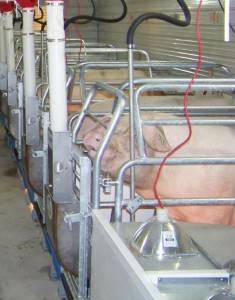
“First of all…” Mark said, “the SowMAX is not a sow feeder. It’s a feed storage device that delivers feed to the sow on demand. It’s like having a bunch of MINI FEED BINS sitting above the feeders ready to deliver fresh feed on demand.
“I’m not sure exactly what you mean.”
Look I’ve been working with sow herds for 24 years in one way or another. The BIGGEST challenge I’ve faced in that time has been training farrowing house personnel to feed lactating sows. It is extremely difficult to feed sows correctly by hand.
Sows are individuals and depending on their genetic makeup some sows are capable of eating much more feed on a daily basis than the group. If you were to look at daily feed intake per sow, you would see a normal bell curve. The bulk of sows will eat somewhere between 18-22 pounds per day, but some of those gals will eat as high as 30 pounds a day! Those are the sows that normally don’t get fed correctly with hand feeding.
If we decide that 20 Lbs is all we will ever feed any sow, then those high appetite sows are going to get short changed. Those are the sows that will typically wean desirable large litters of heavy pigs.
I like to think of today sows as being like high performance race cars. If we don’t fuel up a race car, it will not run. Same with sows, they are capable of high performance as far as producing large numbers of pigs, but we have to get the feed/fuel in them.
How does that change with SowMAX?
SowMAX allows us to feed sows to full appetite without guess work. Our feeding regiment in farrowing goes like this:
For three days prior to farrowing we feed four pounds of feed through the SowMAX. We instruct the farrowing personnel to place two pounds, twice a day in the SowMAX hopper. This gets them up each time and gets them accustomed to activating the trigger lever on the SowMAX.
After farrowing, we continue to hand feed for two more days. On day three, we fill them up and monitor feed disappearance.
Feed disappearance? What does that mean?
Simply put it means that we fill the SowMAX up twice a day and look the amount feed that is gone in the hopper. As long as the sow is eating over half of that amount we just fill it up again and go on. We are only concerned with the sows that aren’t eating; that’s the one that’s having trouble and needs our attention.
“You know Mark, feed is very expensive; what about a producer’s concern that SowMAX may be getting more feed into the sows but that it’s also wasting more feed?”
Our experience has shown the exact opposite. We waste less feed with SowMAX than hand feeding, and that’s easy to figure out. With hand feeding if you guess wrong and put more feed in the feeders than she can eat, it spoils and you end up dumping it out. The SowMAX delivers fresh feed to the feeders….on demand….whenever a sow is ready to eat. Human judgment is eliminated….we don’t have to try and outguess mother nature. Again, we have those MINI FEED BINS sitting there ready to deliver feed whenever she’s ready to eat.
Do you have farms with other types of systems?
Yes, we have automatic systems where feed is dumped from drops into the feeders several times a day. There is less physical labor but it really isn’t any better than hand feeding. You still have to guess on the amount of feed each sow will consume each day. Plus, as the systems get older they take more maintenance; it seems like we are always fixing a switch or replacing a motor. SowMAX works everyday; no timers, no motors, no switches, nothing to wear out.
With SowMAX, we fill the hopper, and we have some flexibility if something goes wrong. In a dire emergency, we still have almost a day’s worth of feed storage at each hopper. We have other systems that use a plastic tube and have almost no storage. We have a lot more cushion with SowMAX than the other systems.
So with SowMAX, you are able to “fuel up the race cars” What differences do you see in performance?
First, there are only two things that make milk, feed and water. A sow produces more milk per body weight than a milk cow. Can you image a dairyman limit feeding a milk cow? That would never happen, yet we expect a sow to produce to her full genetic potential on limit feeding! SowMAX allows us to fully feed sows according to their individual appetite and they produce heavier litters.
Second, we quit condition scoring sows coming out of the farrowing crates that are using SowMAX. Rarely would we have a Two score, they consistently scored as Threes. Because of their better body condition rebreeding is improved.
We have SowMAX in about 5,000 crates in North Carolina. You can bet that any updates or remodels that we do in the future will include SowMAX feeders also.
To learn more go to http://hogslat.com/sowmax-feed-dispenser on our web store.
Ever notice how some people or companies try to make a job more difficult than it has to be?
Today I read an article about a show case farm with an integrated computer system including electronic sow feeding. There is a picture showing a hand held computer programming in the amount of feed that a sow will receive according to its body condition score.
Looks like a complicated and expensive system that isn’t any more effective than hand feeding. If the computer based delivery system puts more feed in front of the sow than she can eat then it spoils and if the system puts in too little she doesn’t get the nutrients she needs for full milk production.
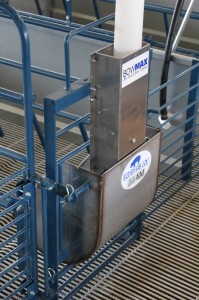
Compare this to feeding with a SowMAX.
You fill the hopper. The sow activates the lever and eats as much or as little as she wants….whenever she wants……night or day.
No guess work. No wasted feed. No under fed animals.
In the same e-mag there was also an advertisement describing an ad lib sow feeder that looked a lot like the SowMAX. One crucial difference though, it described the product as having a “timer that dispenses food at desired intervals over a 24 hour period”
Who’s desired time, yours or the sow’s? Why would you use a timer and motor instead of a lever? Most importantly this feeding dispenser still requires the operator to make a decision on the amount of feed that is metered out in 24 hours.
Again, same story. Feed too much and you’ll get spoilage or feed too little and the sows produce less milk. The SowMAX system lets the sow make the decision instead of a human operator.
SowMAX is the best Ad Lib Feeder on the market today.
- All stainless steel construction instead of plastic or nylon which means it lasts longer.
- Simple mechanical activation instead motor and switches which means no parts to replace.
- Eliminates guess work in determining the amount of feed which means the sows are always feed correctly.
To learn more about SowMAX go to http://hogslat.com/sowmax-feed-dispenser

SowMAX ad lib dispenser
Claiming an Ad Lib Sow Feeder can save feed may seem like a contradiction of terms. How can allowing a sow unlimited access to feed save money on feed?
It’s simple really…sows are individuals with different eating and consumption patterns. Some days they’re extra hungry, some days they’re not. Sows also prefer to eat at different times of day.
It’s hard to guess right when feeding lactating sows. Feed them too much and they don’t eat it all…it spoils in the feeder and you end up dumping it out and wasting feed.
That’s the beauty of the SowMAX ad lib dispenser. The hopper is filled, either by hand or from an overhead auger system, and the sow decides how much she will eat. She eats to appetite without wasting feed…..you’ll see heavier litters; sows stay in better condition coming out of lactation and reduced feed waste.
To learn more go to http://hogslat.com/sowmax-feed-dispenser
A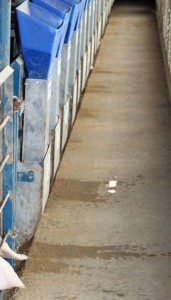 couple of weeks ago I received a call from Fritz Richards, Hog Slat’s national sales manager. Next time you are in North Carolina we need to run out to TDM #29 and take a look at the way they are utilizing a SowMAX feeder for feeding weaned sows.” It just so happened I was going to be in North Carolina the following week so I met Fritz at his office and we set out for the farm. As we drove he filled me in. “They have adapted 30 of the breeding row stalls with small bowl feeders and SowMAX dispensers mounted in the front gate. It’s giving them a chance to compare the results against the other 70 stalls that are fed by the standard method.” “What is the thinking behind that?" I asked. “They know that if they can increase the energy intake of a sow from weaning to first service they will get production benefits. The problem has been it’s tough to increase consumption without over feeding and wasting feed. With the high cost of feed it’s more important than ever to feed sows correctly without wastage.” “We have had several industry production advisors through the farm recently and they were very positive about what they saw.” We showered into the farm and happened to catch the unit manager, Britt Hooper and his staff during their morning break. Fritz spoke with Britt about his early experiences with the SowMAX test. To view a video of his observations please go to http://hogslat.com/sowmax-feed-dispenser
couple of weeks ago I received a call from Fritz Richards, Hog Slat’s national sales manager. Next time you are in North Carolina we need to run out to TDM #29 and take a look at the way they are utilizing a SowMAX feeder for feeding weaned sows.” It just so happened I was going to be in North Carolina the following week so I met Fritz at his office and we set out for the farm. As we drove he filled me in. “They have adapted 30 of the breeding row stalls with small bowl feeders and SowMAX dispensers mounted in the front gate. It’s giving them a chance to compare the results against the other 70 stalls that are fed by the standard method.” “What is the thinking behind that?" I asked. “They know that if they can increase the energy intake of a sow from weaning to first service they will get production benefits. The problem has been it’s tough to increase consumption without over feeding and wasting feed. With the high cost of feed it’s more important than ever to feed sows correctly without wastage.” “We have had several industry production advisors through the farm recently and they were very positive about what they saw.” We showered into the farm and happened to catch the unit manager, Britt Hooper and his staff during their morning break. Fritz spoke with Britt about his early experiences with the SowMAX test. To view a video of his observations please go to http://hogslat.com/sowmax-feed-dispenser
- 1
- 2
- 2024
- 2023
- 2022
- 2021
- 2020
- 2019
- 2018
- 2017
- 2016
- 2015
- 2013












 Україна
Україна Méjico
Méjico